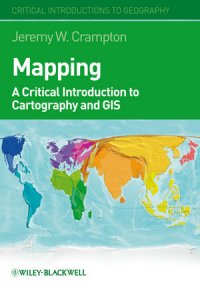
Ebook: Mapping: A Critical Introduction to Cartography and GIS
- Year: 2010
- Publisher: Wiley-Blackwell
- Language: English
- pdf
Mapping: A Critical Introduction to Cartography and GIS is an introduction to the critical issues surrounding mapping and Geographic Information Systems (GIS) across a wide range of disciplines for the non-specialist reader.
Chapter 1 Maps – A Perverse Sense of the Unseemly (pages 1–12):
Chapter 2 What Is Critique? (pages 13–24):
Chapter 3 Maps 2.0: Map Mashups and New Spatial Media (pages 25–38):
Chapter 4 What Is Critical Cartography and GIS? (pages 39–48):
Chapter 5 How Mapping Became Scientific (pages 49–61):
Chapter 6 Governing with Maps: Cartographic Political Economy (pages 62–80):
Chapter 7 The Political History of Cartography Deconstructed: Harley, Gall, and Peters (pages 81–97):
Chapter 8 GIS After Critique: What Next? (pages 98–111):
Chapter 9 Geosurveillance and Spying with Maps (pages 112–127):
Chapter 10 Cyberspace and Virtual Worlds (pages 128–143):
Chapter 11 The Cartographic Construction of Race and Identity (pages 144–159):
Chapter 12 The Poetics of Space: Art, Beauty, and Imagination (pages 160–176):
Chapter 13 Epilogue: Beyond the Cartographic Anxiety? (pages 177–184):
- Examines the key influences Geographic Information Systems (GIS) and cartography have on the study of geography and other related disciplines
- Represents the first in-depth summary of the “new cartography” that has appeared since the early 1990s
- Provides an explanation of what this new critical cartography is, why it is important, and how it is relevant to a broad, interdisciplinary set of readers
- Presents theoretical discussion supplemented with real-world case studies
- Brings together both a technical understanding of GIS and mapping as well as sensitivity to the importance of theory
Chapter 1 Maps – A Perverse Sense of the Unseemly (pages 1–12):
Chapter 2 What Is Critique? (pages 13–24):
Chapter 3 Maps 2.0: Map Mashups and New Spatial Media (pages 25–38):
Chapter 4 What Is Critical Cartography and GIS? (pages 39–48):
Chapter 5 How Mapping Became Scientific (pages 49–61):
Chapter 6 Governing with Maps: Cartographic Political Economy (pages 62–80):
Chapter 7 The Political History of Cartography Deconstructed: Harley, Gall, and Peters (pages 81–97):
Chapter 8 GIS After Critique: What Next? (pages 98–111):
Chapter 9 Geosurveillance and Spying with Maps (pages 112–127):
Chapter 10 Cyberspace and Virtual Worlds (pages 128–143):
Chapter 11 The Cartographic Construction of Race and Identity (pages 144–159):
Chapter 12 The Poetics of Space: Art, Beauty, and Imagination (pages 160–176):
Chapter 13 Epilogue: Beyond the Cartographic Anxiety? (pages 177–184):
Download the book Mapping: A Critical Introduction to Cartography and GIS for free or read online
Continue reading on any device:

Last viewed books
Related books
{related-news}
Comments (0)